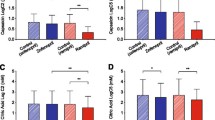Abstract
The effects of inhibition of angiotensin converting enzyme (ACE) and glycopyrrolate on cough caused by inhaled capsaicin were investigated in a double-blind, randomised cross-over study in twelve normal volunteers. The capsaicin challenge was performed before and 2 h after dosing with 75 mg captopril or matched placebo given orally, and 20, 40 and 60 min after giving 1 mg glycopyrrolate IV to each subject.
Captopril and placebo did not alter the cough response when compared to baseline. Glycopyrrolate, however, caused a significant increase in the threshold sensitivity (D2) from baseline, and a significant decrease in the total cough response at 40 and 60 min both after captopril and placebo. The D2-baseline and D2-40 min after glycopyrrolate (mean (SD), respectively, were 3.2 (1.0); 17.9 (4.2) after placebo and 2.5 (8.5); 23.6 (6.9) after captopril.
Elimination of vagal influences implies attenuation of the effects of tachykinins but not those prostaglandins. We postulate that tachykinins, such as substance P, play a more important role than prostaglandins in capsaicin-induced cough.
We conclude that the vagus is important in the capsaicin-induced cough reflex, but, as suppression of this reflex by glycopyrrolate was delayed, the relevant receptors are either poorly accessible peripheral receptors or they are located in the central nervous system.
Similar content being viewed by others
References
Sesoko S, Kaneko Y (1985) Cough associated with the use of captopril. Arch Int Med 145: 1524
McEwan JR, Fuller RW (1989) Angiotensin converting enzyme inhibitors and cough. J Cardiovasc Pharmacol 13 [Suppl 3]: S67–69
McEwan JR, Choudry NB, Fuller RW (1990) The effect of sulindac on the cough reflex associated with dry cough. J Pharmacol Exp Ther 255: 161–164
Karlsson J-A, Sant'Ambrogio G, Widdicombe J (1988) Afferent neural pathways in cough and reflex bronchoconstriction. J Appl Physiol 65: 1007–1023
Choudry NB, McEwan JR, Lavender EA, Williams AJ, Fuller RW (1991) Human responses to inhaled capsaicin are not inhibited by granisetron. Br J Clin Pharmacol 31: 337–339
Sekizawa K, Tamaoki J, Nadel JA, Borson DB (1987) Enkephalinase inhibitor potentiates substance P- and electrically induced contraction in ferret trachea. J Appl Physiol 63: 1401–1405
Thysell H, Anderson KE, Anderson SI, Eckman R (1988) Angiotensin-converting enzyme inhibition — cough and serum concentration of substance P. Eur J Clin Pharmacol 34: 649–650
Fuller RW, McEwan JR, Choudry NB (1989) The abnormal cough reflex: role of prostaglandins. Am J Respir Dis 139: A586
Fuller RW, Jackson DM (1990) Physiology and treatment of cough. Thorax 45: 425–430
Ajayi AA, Lees KR, Reid JL (1986) Effects of angiotensin converting enzyme inhibitor, perindopril on autonomic reflexes. Eur J Clin Pharmacol 30: 177–182
Jacoby DB, Fryer AD (1990) Abnormalities in neural control of smooth muscle in virus-infected airways. Trends Pharm Sci 11: 393–395
Collier J, Fuller R (1984) Capsaicin inhalation in men and the effects of sodium cromoglycate. Br J Pharmacol 81: 113–117
Morice AH, Lowry R, Brown MJ, Higenbottam T (1987) Angiotensin-converting enzyme and the cough reflex. Lancet I: 1116–1118
Choudry NB, Fuller RW, Pride NB (1989) Sensitivity of the human cough reflex: effect of inflammatory mediators prostaglandin E2, bradykinin and histamine. Am Rev Respir Dis 140: 137–141
Buck SH, Burks TF (1986) The neuropharmacology of capsaicin: review of some recent observations. Pharmacol Revs 38: 179–226
Fuller RW, Choudry NB (1987) Increased cough reflex associated with angiotensin converting enzyme inhibitor cough. Br Med J 295: 1025–1026
Fuller RW (1990) The human pharmacology of capsaicin. Arch Int Pharmacodyn 303: 147–156
Foster G, Yeo WW, Ramsey LE (1991) Effect of sulindac on the cough reflex of healthy subjects. Br J Clin Pharmacol 31: 207–208
Choudry NB, Fuller RW, Anderson N, Karlsson J-A (1990) Separation of cough and reflex bronchoconstriction by inhaled local anaesthetics. Eur Respir J 3: 579–583
Nichol G, Nix A, Barnes PJ, Chung KF (1990) Prostaglandin F2α enhancement of capsaicin induced cough in man: modulation by beta2 adrenergic and anticholinergic drugs. Thorax 45: 694–698
Saria A, Martling C-R, Yan Z, Theodorsson-Norheim E, Gamse R, Lundberg JM (1988) Release of multiple tachykinins from capsaicin-sensitive sensory nerves in the lung by bradykinin, histamine, dimethylphenyl piperazinium, and vagal nerve stimulation. Am Rev Respir Dis 137: 1330–1335
Author information
Authors and Affiliations
Rights and permissions
About this article
Cite this article
van Wyk, M., De Sommers, K. & Snyman, J.R. Effects of glycopyrrolate on capsaicin-induced cough in normal volunteers treated with captopril. Eur J Clin Pharmacol 46, 437–439 (1994). https://doi.org/10.1007/BF00191907
Received:
Accepted:
Issue Date:
DOI: https://doi.org/10.1007/BF00191907




